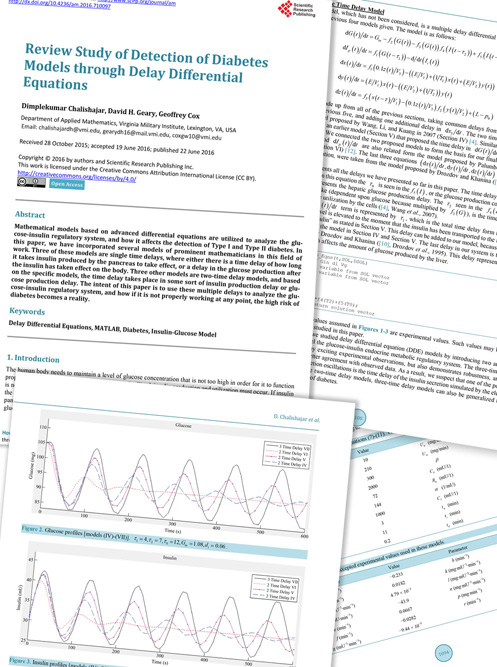Predicting Diabetes
 |
|
Several pages from the article by Lt. Col. Dimplekumar Chalishajar, David Geary '16, and Lt. Col. Geoff Cox are shown . – Copyright © 2016 by authors and Scientific Research Publishing Inc. This work is licensed under the Creative Commons Attribution International License (CC BY); http://file.scirp.org/Html/9-7402957_67581.htm |
LEXINGTON, Va., Oct. 17, 2016 – For the second time in two years, a professor in VMI’s Department of Applied Mathematics has guided a cadet to publishing his research in an international scholarly journal – and this time, the work won a VMI award for research as well.
David Geary ’16 had just graduated with distinction, earning a bachelor’s degree in applied mathematics, when an article based on the research he undertook with Lt. Col. Dimplekumar Chalishajar, associate professor of applied mathematics, was published in Applied Mathematics.
Also receiving authorship credit for the piece, titled, “Review Study of Detection of Diabetes Models Through Delay Differential Equations,” was Maj. Geoff Cox, assistant professor of applied mathematics. Cox helped Geary and Chalishajar with Matlab, a computer programming language used frequently by engineers and scientists.
The collaborative project was recognized with the Wilbur S. Hinman Jr. ’26 Research Award in natural sciences and math, given in May by VMI Research Labs.
Work on the project began in the summer of 2014, when Geary, who was taking a class in differential equations with Chalishajar, approached his professor and asked about independent study opportunities. Chalishajar offered Geary a choice of three topics, and Geary chose one that Chalishajar had been working on for some time: the development of mathematical models having to do with the diagnosis of diabetes.
In his diabetes research, Chalishajar is seeking to use math to predict diabetes diagnosis, or more specifically, the moment at which the human body transitions from a state of wellness to a state of disease.
“When does diabetes start in the body?” Chalishajar asked rhetorically. “We don’t know.”
By 2014 – the same year that Geary began his work – Chalishajar already had diabetes research advanced enough to be published. “Mathematical Analysis of Insulin-Glucose Feedback System” was published in the International Journal of Engineering and Applied Sciences in 2014, with Andrew Stanford ’16 as second author.
In his work with Stanford and with Geary, Chalishajar chose to use delay differential equations, an advanced mathematical concept usually taught only at the doctoral level. In a delay differential equation, the evolution of a system at a certain time is dependent on the state of that system at an earlier time.
Chalishajar had much experience using these equations in his own field of control theory, but he hadn’t used them before at the intersection of math and biology.
The research that Geary and Chalishajar published is the first to investigate three delays – the delay in finding out when the body’s glucose production goes awry, the delay in finding out when the body’s insulin production goes awry, and the effects of the two delays together.
“We are getting extremely good results compared to other researchers,” said Chalishajar. “[The three delays are] the main importance of this work.”
Geary, meanwhile, has been happy to see the fruits of his labor reach the printed page. “It was a great way to see that math can be used in the real world,” he commented. “That’s not just something teachers say to get you to do your homework.”
Now teaching math to high schoolers at J.R. Tucker High School in Richmond, Geary attempts to pass that real-world math lesson along to them. In response to the age-old question, “What do we need this for?” Geary has striven to show students that math does matter outside of school. He’s even had his students fill out interest inventories so he can create lessons that resonate with their passions.
“I just do everything I can to bring it back to math,” he noted.
Chalishajar, meanwhile, is far from finished with guiding cadets to publication. Research by Grant Austin ’19 and Brad Lipscomb ’16 will be published later this year in Applied Mathematics.
– Mary Price
-VMI-
.svg)
.png)